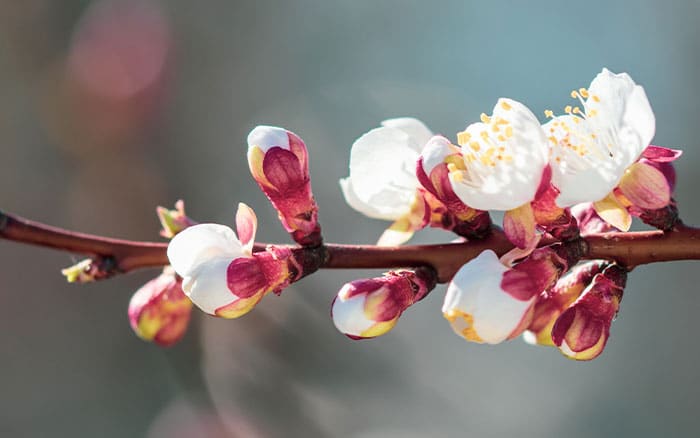Apricots may not spring to mind as a fruit that we tend to grow in the UK…but we can! The juicy texture and delicious taste of homegrown apricots is magical. They are a popular fruit, so popular that in the US, every year there are National Apricot Day celebrations.
Planting apricots
There are many ways to grow apricots; as fans, bushes, pyramid trees or dwarf varieties for potted trees. Apricots thrive in deep, moisture retentive soils that are well drained and ideally slightly alkaline. The best spot to grow is on a warm, sheltered, South-facing wall.
Plant apricot trees between November and March when the tree is dormant.

The best time is during autumn when the soil is still warm. When planting, dig a bucketful of well-rotted matter into the area.
Although they are hardy, they do flower early and are vulnerable to frosts and cold chills. The flowers bloom in February – March, and they are pretty and pale pink in colour.
The most common cause of poor fruiting tends to be frost damage to the flowers or inadequate pollination. Therefore, covering the trees with horticultural fleece can help to protect the blossom from frost. However, the fleece shouldn’t touch the flowers.
Care and grow

Newly planted trees should be watered in spring and summer, as well as before a predicted drought. Mature trees will benefit from watering too.
Watering is especially important when the fruit is beginning to swell. Then, in late February, feed the plant with a granular fertiliser to give it the boost it needs.
When flowers bloom, you can help with the pollination process by hand-pollinating. Midday on a dry and sunny day, use a cotton bud to hand-pollinate.
It’s best to prune in spring or from the end of July to the end of August. This is because apricots bear fruit on shoots that grew in the previous summer and shorter growth from older wood.
Take your pick
From late July to August, the fruit will be ready to harvest. It will feel soft and will detach from the tree with ease. When harvested, apricots should be stored at room temperature because refrigerating them halts the ripening process.
You’ll make the most of the flavour by eating them immediately after harvesting because they can only be stored for a few days.

Apricots are low in calories and fat, as well as being an excellent source of vitamin C. They are also a great source of vitamins that are essential for eye health, vitamins A and E.

I’ve pondered often about why Apricots are not grown in the UK. When we lived in South Africa in Randburg (close to Johannesburg) the Winters were very cold almost the same as in South East Hampshire, England, so what a lovely surprise to know we can try to grow some here as we did in SA. Finding space will be a bit of a problem – may even put one in the front yard…